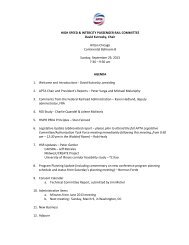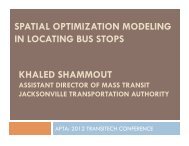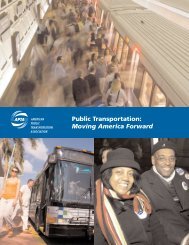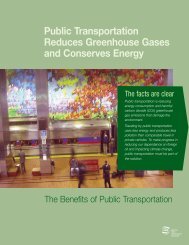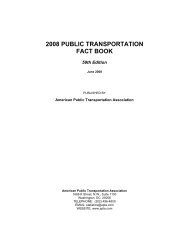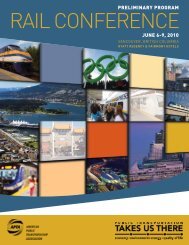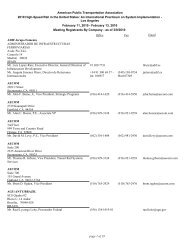2012 APTA Fact Book Appendix A - American Public Transportation ...
2012 APTA Fact Book Appendix A - American Public Transportation ...
2012 APTA Fact Book Appendix A - American Public Transportation ...
You also want an ePaper? Increase the reach of your titles
YUMPU automatically turns print PDFs into web optimized ePapers that Google loves.
<strong>2012</strong> <strong>Public</strong> <strong>Transportation</strong> <strong>Fact</strong> <strong>Book</strong>,<br />
<strong>Appendix</strong> A: Historical Tables<br />
Page 128<br />
fringe benefit payments for employees of the transit agency are included, fringe benefit payments for<br />
employees of purchased transportation service are reported in purchased transportation expense<br />
General Administration Employee is an operating employee who is an executive, professional,<br />
supervisory, or secretarial transit system person engaged in general management and administration<br />
activities: preliminary transit system development, customer services, promotion, market research,<br />
injuries and damages, safety, personnel administration, general legal services, general insurance, data<br />
processing, finance and accounting, purchasing and stores, general engineering, real estate<br />
management, office management and services, general management, and planning.<br />
Non-Vehicle Maintenance Employee is an operating employee who is an executive, professional,<br />
supervisory, or secretarial transit system person engaged in non-vehicle maintenance, a person providing<br />
maintenance support to such persons for inspecting, cleaning, repairing and replacing all components of:<br />
vehicle movement control systems; fare collection and counting equipment; roadway and track;<br />
structures, tunnels, and subways; passenger stations; communication system; and garage, shop,<br />
operating station, general administration buildings, grounds and equipment. In addition, it includes<br />
support for the operation and maintenance of electric power facilities.<br />
Number of Employees is the number of actual persons directly working for a transit agency, regardless<br />
of whether the person is full-time or part-time. Persons employed by agencies contracting to the transit<br />
system are not counted.<br />
Operating Employee is an employee engaged in the operation of the transit system. Operating<br />
employees are classified into four categories describing the type work they do: general administration,<br />
non-vehicle maintenance, vehicle maintenance, and vehicle operations.<br />
Salaries and Wages are payments to employees for time actually worked. Only salaries and wages for<br />
employees of the transit agency are included, salaries and wages for employees of purchased<br />
transportation service providers are reported in purchased transportation expense.<br />
Total Compensation is the sum of Salaries and Wages and Fringe Benefits. Only compensation for<br />
employees of the transit agency is included, compensation for employees of purchased transportation<br />
service providers is reported in purchased transportation expense.<br />
Vehicle Maintenance Employee is an operating employee who is an executive, professional, secretarial,<br />
or supervisory transit system person engaged in vehicle maintenance, a person performing inspection<br />
and maintenance, vehicle maintenance of vehicles, performing servicing functions for revenue and<br />
service vehicles, and repairing damage to vehicles resulting from vandalism or accidents.<br />
Vehicle Operations Employee is an operating employee who is an executive, professional, or<br />
supervisory transit system person engaged in vehicle operations, a person providing support in vehicle<br />
operations activities, a person engaged in ticketing and fare collection activities, or a person engaged in<br />
system security activities.<br />
ENERGY USE AND VEHICLE POWER DEFINITIONS:<br />
Alternate Power is fuel or electricity generated from fuel that is substantially not petroleum.<br />
Electric Power Consumption is the amount of electricity used to propel transit vehicles, also called<br />
propulsion power. Does not include electricity used for lighting, heating, or any use other than<br />
propulsion power.<br />
Fossil Fuel is any fuel derived from petroleum or other organic sources including diesel fuel, compressed<br />
natural gas, gasoline, liquefied natural gas, liquid petroleum gas or propane, and kerosene.



